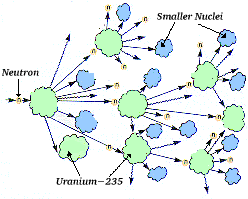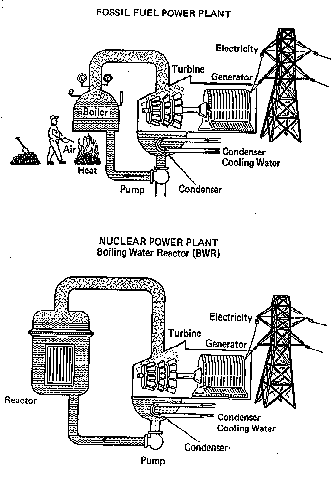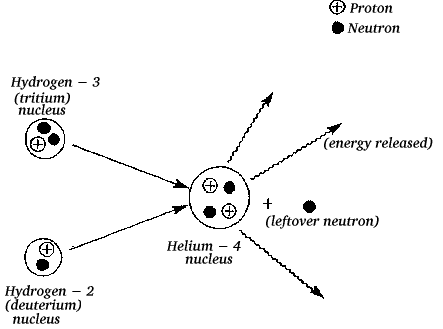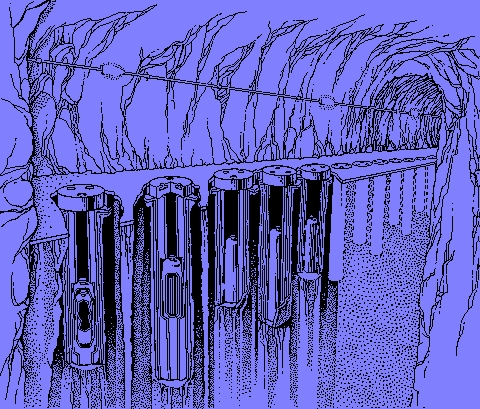Nuclear Energy
Nuclear Energy
back to Contents of Entire Course...
Ionizing Radiation
Examples of Radiation Risk
Nuclear Energy Fission
Fusion of Hydrogen to make Helium
Environmental
Effects of Various Energy Sources - Comparison
Chernobyl, Ukraine
Radioactive Waste Repositories
Links
adapted to HTML from lecture notes of Prof. Stephen A. Nelson Tulane
University Ionizing Radiation
Ionizing Radiation is radiation that ionizes (or removes electrons from) material that it passes through.
Examples of Ionizing Radiation include:
- Neutrons - Have high enough energy to be able to knock electrons off of nearby atoms.
- Alpha particles - Helium atoms with no electrons.
- Beta Particles - Electrons
- Gamma rays - Very high energy radiation.
- X-Rays - Another high-energy radiation, the main source of which is medical equipment.
- Cosmic rays - Photons and alpha particles. The earth is being constantly bombarded with this type of radiation; the average person is hit by around a hundred cosmic rays a second
Radioactivity is natural; we have been bombarded by ionizing radiation from Uranium (U), Potassium (K), and Thorium(Th) as well as by cosmic rays all our lives.
Billions of years ago when life first started there was much more natural radiation than at present. Life has evolved with natural ionizing radiation. Some maintain that without the natural radiation which causes genetic mutations, evolution would not be possible.
| Average Relative Radiation Exposure of Humans | |
|---|---|
| Source | Relative Exposure (%) |
| Cosmic rays | 24 |
| Terrestrial (U,K,Th) | 32 |
| Medical (X-rays) | 40 |
| Nuclear fallout | 2 |
| Misc. nuclear plants, waste | 2 |
| TOTAL | 100 |
| Ionizing Radiation | |
|---|---|
| Dose (mSv) | Effect |
| 5,000 | Lethal |
| 1,000 to 2,000 | Vomiting, fatigue, increased rate of abortion within first 2 months, temporary sterility in males |
| 500 | Physiological damage |
| 50 | Maximum allowed for nuclear employees per year |
| 1.0-2.5 | Natural background |
- Dosages are based on relative effects of different types of ionizing radiation on living tissue.
- Effect on life more damaging to tissues that regenerate rapidly such as bone marrow, spleen, lymph nodes, skin, embryos, etc.
| Dosage | Effect |
|---|---|
| Extremely high dose | burns and damage to brains, die within 48 hours |
| Lower Doses | Diarrhea, bleeding and hair loss |
| Increased susceptibility to infection | |
| Cancer | |
| Lowest (Natural) Dose | Genetic mutation (some argue that this is necessary for evolution) |
- There is no question that radiation is extremely dangerous at high levels but we are not sure of its effect at lower levels.
- Studies on the subject do not always agree; some studies suggest that slightly increased dosages actually result in a decrease in the chance of cancer. (Example: Nuclear power plant employees).
Examples of Radiation Risk
- Normal background is 1 - 2.5 mSv.
- Japanese atomic bomb survivors have lower incidence of cancer then control groups.
- In the western U.S., people receive 1 mSv per year more radiation (due to elevation), but they have a 15% lower cancer rate than do people in the eastern U.S.
- In China two groups of 70,000 people with a dosage difference of 2 mSv were studied. The group with higher doses of radiation had 1/2 of the cancers.
- In the U.S. 28,000 nuclear workers were compared to 33,000 non-nuclear workers. The nuclear workers had a lower cancer rate and a total mortality rate that was 24% less then the non-nuclear workers.
Nuclear Energy Fission
- A nuclear reaction derives energy from:
- Fission of uranium or plutonium or
- Fusion of hydrogen to make helium.
- Uranium has two isotopes:
- U-238 - about 99% of natural occurring uranium is in this state.
- U-235 - only 1% or naturally occuring uranium.

- For this reaction to occur, U-235 or Pu-239 need only be enriched slightly. U-235 with a half life of about 700 million years is found in nature. Pu-239 with a half-life of 24,000 years is made in a reactor. ( U-238 -> P-239)
- A breeder reactor is designed to increase the amount of Uranium-238 that is transformed to Plutonium-239.
- The Pu-239 produced can be used for fuel in a nuclear reactor or in an atomic bomb. It is relatively easy to separate Pu-239 from the reactor fuel.
- How does a reactor work?
- We first start off with fuel rods which are made up of U-235 pellets which have been enriched to about 3% (from original 1%).
- These rods are interdispersed vertically into a water bath (in U.S. reactors) with control rods which contain neutron absorbing material.
- The control rods are raised to allow the fuel rods to react with each other. The water bath itself helps control the rate of reaction.
- Once the reaction starts the rods are lowered until the proper rate of reaction is achieved.
- Another enclosed water system constantly brings new cool water into the system and takes the heated water out to a heat exchanger unit.
- This unit takes this heated water and pushes it towards a turbine.
- A cold water system is run around this heated water causing a huge heat differential which allows the turbine to move creating electricity.
This entire system is enclosed in a containment building for further protection in case of a accident.
Comparison of coal and nuclear power plants:

As can be seen, the two types of plants are basically the same...the only real difference is in the method of heat generation. In Australia there is one nuclear facility which produces medical isotopes. In the U.S., as of 1988 there were 110 operable nuclear power plants, 1 in construction and 10 for which construction permits had been granted. None of the new plants were completed and put into energy production.
- Nuclear power plants are only good for about 30 years... after that time, they need to be torn down and disposed of.
- A fuel assembly needs to be replaced every 2.5 years or so to maintain efficiency.
- At this time the fuel assembly produces 10,000 watts of energy.
- After 100 years it produces 100 watts of energy.
- Spent fuel rods are placed in cooling pools for a few years, and then sealed and stored in yards near the reactors.
Environmental impacts and concerns of Fission:
- Waste disposal
- Accidents
- Weapons proliferation from breeder reactors
Fusion of Hydrogen to make Helium

In this reaction a tritium nucleus (hydrogen 3) is combined with a deuterium nucleus (hydrogen 2) (fused) to create a helium 4 nucleus. This reaction releases energy and neutrons.
Environmental Effects of Various Energy Sources - Comparison
| Environmental Effects of Various Energy Sources | |||
|---|---|---|---|
| Coal | Oil | Natural Gas | Uranium |
Disturbed Land
|
Brine | Pipeline Construction | Disposal of Nuclear Waste |
| Pipeline Construction | |||
| Oil Spills | Carbon Dioxide | Some Radioactive Gasses (Contained) | |
| Nitrogen Oxides & Acid Rain | |||
| Carbon Dioxide | |||
| Radioactive Gasses |
Environmental Effects of Various Energy Sources Coal Oil Natural Gas Uranium Disturbed Land
- Mining
- Ash Disposal
- Acid Mine Drainage
| Accidental Deaths per Billion Watt Power Plant | ||||
|---|---|---|---|---|
| Energy Source | Extraction | Processing and Transport | Power Plant | Total |
| Coal | ||||
| underground | 1.7 | 2.32 | 0.01 | 4.0 |
| strip mining | 0.3 | 2.32 | 0.01 | 2.0 |
| Oil | 0.2 | 0.13 | 0.01 | 0.4 |
| Natural Gas | 0.16 | 0.03 | 0.01 | 0.2 |
| Uranium | 0.2 | .011 | 0.01 | 0.2 |
Chernobyl, Ukraine
April 26, 1986 - the worst nuclear accident in the history of nuclear power generation occurred here. Operators of the plant were testing the emergency core cooling system. Power in the system rose rapidly. A steam explosion occurred followed by a hydrogen explosion. The graphite moderator began to burn. The outside containment structure, although substantial, was not adequate enough to hold the accident. Some 30 workers who were trying to prevent further probems received lethal dosages of radiation. The local people as well as the world were not informed of the accident until several days later. The wind was blowing toward the northwest. Sweden was alerted to the problem when it found unusually high radiation counts in its atmosphere. Eventually some 400,000 people were evacuated from the area.
I131 has a half-life of 8 days. Many people recieved substantial doses of I131 as word about the accident was not released for several days.
Thyroid cancer in children that were living in this area has increased dramatically. Iodine is concentrated in the thyroid gland in humans.
Other cancers have not yet shown an increase, but it can sometimes take up to 20 or 30 years for an increase in certain cancer rates to show up.
The psychological stresses related to this accident seem to be having the worst health effects on the people.
Radioactive Waste Repositories
(examples from U.S.A.)
There is a need for repositories for two types of waste:
- Low level
- High level
Low Level Waste
- Medical or Commercial products.
- Examples: Equipment, fabric, wood, plastic, glass, sludges, acids
- Irradiated material from reactors.
- Each state is supposed to have a repository where the material will be isolated for 500 years.
High Level Waste
- Spent fuel rods
- Plutonium, Uranium, Thorium
- Fission products
- Nuclear weapons waste, liquid and solid.
High Level Waste Repositories
- By the year 2,000 there will be 178,000 canisters ready for disposal.
- Requirements:
- waste to be in stable form (not liquid)
- Glass
- Synroc
- Spent fuel rods
- Should result in only 1,000 deaths in 10,000 years.
- Waste package should stay stable for 1,000 years.
- Isolated from groundwater as long as possible.
- Waste package designed to provide least possible exchange with groundwater after contact.
- Waste will not reach biosphere for at least 1,000 years.
- Fuel Rods:
- The site will probably be the size of a typical underground mine.
- It will have tunnels leading to vertical containment areas.
- Spent fuel rods will be placed into these containment shafts.
- These shafts will probably be kept open for the first few years to allow heat to escape, after which they will be sealed off with concrete.

What will a high level nuclear waste repository look like?

The government considered three possible sites for such a repository:
- Basalt in Hanford, Washington
- Salt basin in New Mexico
- Welded volcanic tuff in Yucca mountain, Nevada
Congress has decried that only Yucca Mountain should be considered for non-defense waste. Yucca mountain has some advantages choice for this repository because:
- Arid climate - there is no ground saturation by rain.
- Rocks are made up of welded volcanic tuff, which is nearly impermeable.
- The water table is 500 meters below the site.
- The welded tuff contains zeolite and zeolite should be able to trap radioactive ions released from the site, and keep them out of the groundwater.
A problem with Yucca Mountain is that the site area is in an area of active faults (earthquakes). If an earthquake occurred on a fault crossing the repository it could pump water into the repository and hasten migration of the high level waste.
Agencies involved in high level waste site selection:
- DOE - Department of Energy
- AEC - Atomic Energy Commission
- NRC - Nuclear Regulatory Commission
- GAO - General Accounting Office
- TRW - Corporation doing scientific investigations
- EPA - Environmental Protection Agency
- Nevada State Agencies
Links
The U.S. Energy Information Administration maintians a page covering many various energy sources, including coal and other fossil fuels, as well as nuclear energy.
Nuclear Energy Pro's and Con's Page This page doesn't include any discussion in itself, but has a large array of links arguing both sides of the topics.

